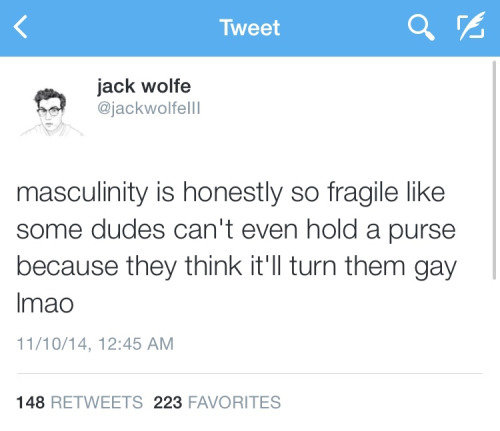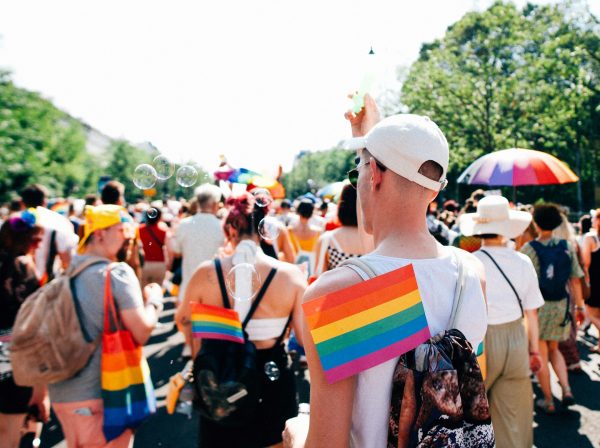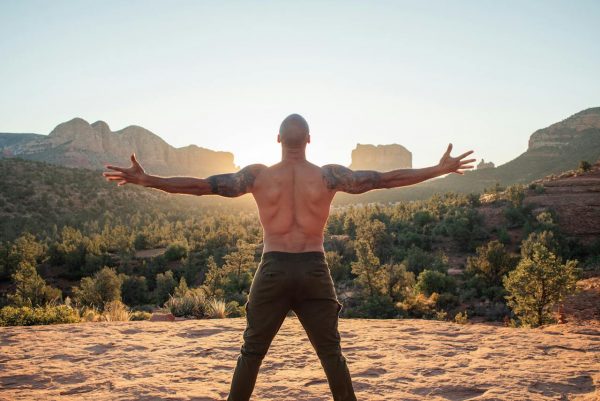There’s a hashtag making its way around Twitter currently that speaks volumes about where dominant views on masculinity stand.
The hashtag itself, #MasculinitySoFragile, is critiquing how masculinity is expressed, what it means it means to express or perform masculinity (or not to express or perform it), and how it is defined and how it is seen. Not what it means, but rather what does society say it means? As a structural abstract, masculinity is, well, fragile. There’s a number of reasons as to why this may be, all complex and interlocking. A primary reason among them is that we do not get to define for ourselves, as individuals, what it means to be masculine (or feminine for that matter). As a concept, it is toxic, which in turn leads to that toxicity seeping into personal and societal expressions and performances of it. Masculinity itself is not toxic; what dominant rhetoric defines as masculine–or perhaps more correctly would be what it means to be “manly”–is toxic.
Constructions of masculinity, maleness, and being “manly” is a topic broad and complex enough for wide conversational analysis. The hashtag is a credible, accessible base for initiating discussions of the sort. The fact is that the hashtag is not being used to criticize men; it is critiquing why masculinity is associated with aggressiveness and how that is expressed through individual behavior and group-think, why people so easily feel masculinity is undermined by other expressions of “manliness” and when they feel that their own is being challenged–even if it is not–it is presumed to be a personal slight. This alone is an example of its fragility.
Under #MasculinitySoFragile one can find tweets such as “#MasculinitySoFragile that it can’t be a Han Solo cosplay, it has to be a ‘Lady Han Solo’ cosplay” and “#MasculinitySoFragile that we have to gender hairstyles (man-braids, man-buns)” and “#MasculinitySoFragile men need to rev their engines at me instead of using their words,” or “#MasculinitySoFragile men get offended when I hold the door for them.” Other tweets are more heartbreaking: “#MasculinitySoFragile that being attracted to a trans women results in that woman being killed,” and, “A guy told me ‘in 2015, rape should be acceptable’ #MasculinitySoFragile.” Many men have jumped into the conversation, adding their constructive input and sharing their experiences using the hashtag medium; some have said it has opened their eyes to toxic masculinity as a construct and expectation versus masculinity itself. There are a plethora of tweets within the hashtag that talk about the need to put ‘no homo’ at the end of compliments from one man to another. Recognition of it as an extension of kyriarchal power structures, one Twitter user said that “it’s [benificial] because it [serves as] a roll-call of male victims of patriarchy.”
Unfortunately, like many other social justice hashtags, it is rampant with trolls. Trolls are to be expected, but it’s scary to think that a good amount of these reactions are not trolling: there are people responding to the hashtag with threats of rape and violence. One, for example, asserts “I challenge any female tweeting unironically with #MasculinitySoFragile to last three rounds against me in a fight. We’ll see who’s fragile.” Other, less straightforwardly aggressive ones (though aggressive nonetheless) include “if Trump were president already he wouldn’t stand for all this ‘women’s rights’ bullshit.” This hashtag isn’t a critique of men, yet men responding aggressively–that is, in a hypermasculine manner–treat it as a critique. They treat it like a personal attack, accuse people using the platform of not allowing men to be men, thus proving the point of the hashtag in the first place. Men and masculine people are not inherently violent; feminists often state this as a center point of arguments when discussing that we are all victims of the patriarchal facet of the kyriarchy; we believe men are rational human beings who can control themselves despite popular notions of inherent masculinity (such as the analogy used when body policing in which certain people argue that if a woman or other femme-type folk is wearing revealing clothing, it’s akin to being around a ‘shark’ while ‘wearing a meat suit,’ and thus have no reason to be offended or frightened when they are harassed on the streets). It is toxic forms of masculinity and people who express or perform that toxicity who are internalizing what this hashtag is and what the people using it have to say.
Personal attacks? Harassment? Feeling it is necessary to respond with hashtags like #FeminismSoFragile so they can rant violently? These actions and reactions demonstrate the need for #MasculinitySoFragile and similar hashtag platforms for social critique, commentary, and sharing of mutual experiences with toxic masculinity, be it street or online harassment; harshly criticizing boys and men for falling outside of prescriptive masculinity; using ‘gay’ as a slur; or any other form.
Saying aggressive responses are useful would be incorrect because many manifest as threats to the emotional and physical safety of LGBTQIA+ individuals and women/other femme-type folk using the hashtag. However, I do believe on some level the fact that there are so many demonstrations of this toxicity within the discussion is a productive factor. It means the underlying message is working and gives people who may have misunderstood it as a critique of masculinity as opposed to a critique of prescriptive, expected, socially constructed and enforced ‘manliness.’ It’s a tangible way to see the concept we are critiquing in action–a starting point for some people’s unpacking, and critical analysis of how patriarchy does hurt everyone who lives under its hegemonic shadow.





